Exercises I Do At Home!!!
This section provided an overview of specific exercises I did at home to help my son deal specifically with issues of partiality processing.
Given what I knew of Zachary's inability to integrate the parts of his world into the whole, his inability to understand the whole without first understanding all the parts within it, there were several exercises I came up with for Zachary. At the time I had originally come up with these, I thought Zachary's problem had to do primarily with an almost fanatic need for order. A few months later, I came to the realization that Zachary's problems were, more specifically, with a subset of the ordering function - the processing of partialities or parts to the whole!
The fact that more boys had autism than did girls also made me wonder in terms of the fact that boys, generally, were more “spatial” or “ordered” in their thinking than were girls. Girls tended to be better at communication and social issues. Boys were, generally believed to be better in math and physics, etc. Perhaps this was simply an old stereotype, but – if it was true, it sure made me wonder! I had no way of knowing with certainty, but, again, this was all rather interesting!
The fact that more boys had autism, yet those girls who did have it seemed “more severely” impacted in many cases, also made me wonder if this was somehow related to the fact that certain vaccinations were made from the cells of an aborted fetus (i.e., the rubella and smallpox vaccines). I wondered what the sex of that aborted fetus had been – and what the impacts could be of, for example, injecting female dna into a male, or another female’s dna into a female – interesting issues indeed!
In my opinion, autistic children were all too often in a drug-induced state as a result of the natural opiate effect of casein and gluten on their bodies. Obviously, I did not believe that optimal learning could occur if a child was still suffering from this natural opiate state. Thus a diet free of casein and gluten had to be seriously considered by parents before undertaking these exercises. Learning required a clear mind and you simply did not have that when in a "drug induced" state. For Zachary, alleviating the natural opiate effect of casein and gluten meant he necessitated a complete diet overhaul. He was also on a diet low in phenols.
My point here, was simply that I strongly believed a child needed to be alert and aware of his surroundings to be able to learn in an effective and efficient manner. In my opinion, modern behavior therapy often fell short in that it did not first necessitate removing casein and gluten from the diet of autistic children.
As such therapy became like forcing a child to lift a 50 pound barbell... it would be nearly impossible for him to do unless physically fit... and even if the child could do it... then what?...just put it back down? What was the purpose of that to a child? Why force a child to do a task he does not understand because he was in a drug-induced state? What was the purpose of doing a task that had no "meaning" to it from the child's perspective - a "meaningless task" - and then reward him for doing that "meaningless task"? In such cases, there was no purpose to it - no result of any kind other than a forced, learned response to a forced "task/reward" system. In such "meaningless" tasks there could be, ultimately, no true reduction in stress, no real "carry over" of what had been learned to other situations...so, again, why do it? A child needed to understand the meaning behind the task, and for that, he needed to be thinking clearly.
Once the natural opiate effects of casein and gluten had been removed, Zachary thrived! The point of my exercises was not simply to generate some kind of learned response to a "meaningless" task... it was to actually help Zachary learn to cope with his world. A "meaningless" task, one a child did not understand because he was in a drug-induced state does nothing for him, and like the lifting of a 50 pound barbell - yes, in some cases, you would encounter children who could do "the task", but once "done" if that task was meaningless to the child - then what? And what about all those children who failed the task completely?
I, therefore, encourage all parents to find a doctor who would help them address their child's dietary issues, as I did believe this was critical for these children to achieve their true potential. DAN! (Defeat Autism Now!) trained doctors were a good place to start. The list was maintained by the Autism Research Institute, in California. Undoubtedly, children who were not on a casein and gluten free diet could also benefit from these exercises, however, I did believe that having a clear mind made the lessons go much, much further! Why give a child a 50-pound barbell to lift - an almost impossible task to do and understand - when simply by removing casein and gluten, and allowing for a much clearer mind, a 2-pound barbell would work just as well in completing the task, and would, most likely, allow many more children to complete it successfully! Parents had to take the responsibility for removing the obstacles they could and needed to do so when it came to creating an optimal learning situation.
For more on the casein and gluten free diet, I encouraged all parents to read the first book I wrote: Saving Zachary: The Death And Rebirth Of A Family Coping With Autism and Kirkman Labs' Guide To Intestinal Health In Autism Spectrum Disorder. This valuable book was available for FREE either online by going to: http://www.kirkmanlabs.com or by calling the company directly at: 800-245-8282 and requesting a copy. This guide was certainly something that could be shared with doctors to help them understand the dietary issues of autism as well. This was a difficult diet to follow, but in my opinion, one that was well worth it! As such, I encouraged all parents to seriously consider a casein and gluten free diet for their autistic children.
There were many doctors who simply did not understand these issues with casein and gluten in the autistic but there were many who did. Parent discussion boards were great places to get referrals. I had placed a link on my website, http://www.autismhelpforyou.com to over 330 autism parent discussion boards and a couple of key ones were also listed in the beginning of this section on First Steps For Parents! By far, the best are the enzyme, mercury, and diet related boards! There were certainly good behavior therapy boards, too, but I had not really frequented those.
"Other Parents" were a tremendous source of information when it came to what could be done to help your child because this broad category of "parents" includes doctors, lawyers, chemists, biochemists, teachers, law officers, researchers, therapists, and last, but certainly not least, those valuable stay-at-home moms who all too often were the ones who "noticed" those critical observations that could often be so key to the puzzle of autism! I encouraged all parents of the autistic to consider joining a couple of message boards - parents would be amazed at the amount of information available from other parents and at their willingness in helping others to figure out where to start and what to do to start helping your child. If nothing else, these parents, who together had a wealth of knowledge and experience could help steer others towards a potential area to investigate when you just had no idea as to where to go or what to do! :o) Parent discussion groups were also great places to get referrals for doctors who were experienced in dealing with the autistic, from a diet/supplement, chelation or behavior therapy perspective.
Thus, the first thing to consider was the removal of the drug-induced state. Then, the behavior intervention could begin. I found that I could do valuable intervention in my home...and it certainly did not cost me tens of thousands to do so. I just exposed Zachary to the "in between" situation, something he had in everyday life anyway, only now, his "exposure" to these "everyday in between" situations would be used as "therapy" and be very focused on one particular thing - helping him cope with partiality! I exposed Zachary to these simple tasks - over, and over, and over again. I could do the same exercise 30, 40 even 50 times a day. This was not difficult to do at all... it simply required a little persistence on my part. This sounded like it involved a great deal of work and time, but truly, it was much simpler than it sounded, and involved much less time than one would think, as parents would see from the various exercises I did with my son. For Zachary, it was just a matter of "increasing frequency of exposure" to the "not ordinary" or "in between" situation... and, explaining the situation best I could - and this was actually something that was rather easy to do. :o)
In doing all exercises, I found it was critical to "put things away" for a few days and then take them out again...that helped me gauge Zachary's progress because I could see if his frustration levels were the same or had decreased when the exercises were "used again" after a while "away from them" – and it also helped prevent allowing him to create “new entities” out of my tools.
The idea behind all these exercises was simply to help Zachary cope with partiality and the realization that things were not perfect and that somehow, he had to be able to adapt to that. I wanted Zachary to be able to allow for the "in between" situations, or the "non-ordinary", for him to see that although there was a need for "order" in life, not all things had to be "perfectly ordered" and, to make him see, that in many cases, “parts” were ok, too!
The fact that I could literally turn Zachary's frustrations "on and off like a switch" told me I was on the right track.
Also, in doing these exercises with Zachary, I saw that they involved "real work and effort" on his part as he was very tired after we did these things... and that was normal. Having studied psychology through graduate school, I knew that "therapy" was often hard and exhausting work for the person going through it and, often, for the therapist, too! As such, I was careful to gauge "when he had had enough" and allowed for "breaks". I found that when I stopped "working with him", Zachary immediately wanted an "order fix" as I came to call it – his coping mechanisms to deal with partiality always came “out”.
The difficult part for me was to control "order fixes" as much as possible so that he could get the stress relief he needed yet, I had to make sure that, as much as possible, his "order fixes" were either very short or involved more "productive" activities. Ideally, I wanted the need for an "order fix" to be "satiated" by everyday things that did require order, like putting away toys, working on the computer on educational software, watching an educational video, etc., as opposed to allowing the "order fix" to be one such as "spinning". Zachary had to learn that it was ok to have some order, but that satiating his need for order had to come from "appropriate" tasks that required order, not from engaging in meaningless activities. I say "meaningless" here only in the sense that activities such as "spinning" do nothing to teach Zachary anything... although I was well aware of their "stress relieving potential" for the autistic child (and as such, at times, these activities, although meaningless in what they teach, could be used as valuable coping tools when life simply was too much to handle!).
I found that after time away from these exercises, when they were "picked up again", Zachary did experience renewed frustration, but the level of that frustration had often been significantly reduced in terms of intensity or actual time it lasted. As such, I knew these exercises were helping him learn to cope with issues of partiality. In general, it did not take much time to "regain" lost ground due to the simple lapse of time. The fact was, I knew Zachary needed a break too... and a "break from things" was the best way for me to see whether or not what I was doing worked.
Basic tools I used in working with Zachary included the following:
Plastic eggs - about 2-dozen, wooden blocks, puzzles/various puzzle pieces (puzzles with missing pieces were good too!) large Lego blocks, an empty egg carton, Rainbow Stix (multi-colored mechanical pencils available at Staples office supply stores), a small basket (anywhere from 4 inches to 8 inches across is good) or large drinking cup, my own body parts (fingers, legs, arms, etc.), bandages, tape (duct tape, masking tape, etc.), rubber bands, hair barrettes/clips, etc., everyday household items or things I could find outside (laundry, small rocks, acorns, etc.) and certain activities, like going for walks also provided great opportunities to further work these issues.
I found I could pretty well do my exercises simply with things I already had around the house, and as such, I did not need to spend a fortune to really make a difference for my son. Using everyday items he was familiar with also had the added benefit of using "tools of everyday life" and that, I was sure would help him cope with that everyday life! :o)
The goal of all these exercises was to provide or stimulate flexibility by "breaking order" in daily life and forcing Zachary to accept the "in between" situation... the "partial situation" in many things. Ultimately, I wanted Zachary to be able to do all these things, physically, himself...to have him, literally, participate in doing the "unusual" or “in between”. Only then would I know that he had truly "become flexible" and that he could better cope with issues of partiality. The key was to increase his flexibility...using everyday objects...and doing it in a fun way.
I did not believe in punishing Zachary as he worked through his issues with partiality and often reacted by using one of his many coping mechanisms (i.e., screaming, running away, etc.) even if those coping mechanisms were difficult for me to deal with at times. I knew his brain forced him to be the way he was – and that was something that was critical be remembered in working with Zachary.
In doing these exercises, it was also important to always make use of Words To Cope to help Zachary when things simply got a little too stressful. I encouraged all parents to become very familiar with these words (see Language section for more on Words To Cope©) and to use them frequently throughout the day in helping their child deal with the world about him. It was also critical to "Label Everything". Labeling was the most CRITICAL and VALUABLE tool parents had in helping to recover their children from autism, because labeling helped define the "parts" to the "whole" for a child who was constantly trying to "break the code" to life... to understand the world about him!
Patience, understanding, labels, fractions, words of quantity, words to cope and creativity... absolutely key tools in working with the autistic child!
There was no doubt in my mind that labeling everything was by far the most useful physical tool parents had to help them in the recovery of their autistic child. In order to label those things that seem to be the most difficult for the autistic child - parts - it occurred to me that the best way to teach how "parts" form a whole was actually through the use of fractions, because, as stated earlier, when you define even a part, or a fraction of something, that "part" takes on an identity of its own. In explaining the concept of fractions to Zachary, I used objects made specifically to teach "fractions" as well as "words that teach quantities". For example, words like "a little", or "some" were words that helped define "parts" to the whole and as such, these labels, in addition to making use of actual physical objects to teach fractions, I found to be invaluable!
Fractions and Words That Teach Quantity
2 Key Tools In Teaching The Concept of “Parts To A Whole” The Autistic Child And Allowing Him To Better Cope With Everyday Situations!!!
Although I knew Zachary had made great strides, I also knew he still struggled with the need for "all or nothing" in almost everything! I had thought long and hard about the best way to "break" this need of his... and I finally came up with the BEST way to approach it... the PERFECT way to teach the "in between"... by teaching FRACTIONS and Words of Quantity (see Language Section) as I called them... words that helped illustrate the "partial" or "in between" situation. I tried this and it worked exactly as I had expected. This was sssssssooooo exciting!!!
The idea here was to teach the CONCEPT of "parts" versus the "whole". This was key to teaching the "in between"...what lies between the "nothing" and the "all". Once Zachary saw how "parts" made up the whole, then I could apply that to many, many things in life. He would now have that critical "label" (the fraction) he needed to make sense of his world when it came to the "in between" situation and to figuring out how "parts" can come together to form a whole. I expected this would greatly increase his flexibility in how he looked at things and his ability to cope with the real world. For example, when he wanted to open the door completely, I could say: "let's open it halfway"... when he wanted me to roll down the car window all the way, I could say: "no, let's leave it up 3/5th of the way" and so on. I could show him how trucks or trains were only partially filled... I could show him that his sandbox buckets could only be filled 1/3 or the way, or 9/10th of the way - instead of him always filling them up completely all the time and not being able to allow for the "in between" situation. I could take a measuring cup and show him the various levels by filling it up 1/4 of the way and showing him "1/4" on the cup, etc. So, the key was just to teach the CONCEPT of "parts" verses the "whole".
Note that the tools I used (below) were for grades 2-6... but, that did not matter. Zachary did not need to learn how to add or subtract or multiply or divide fractions... he just had to learn the concept behind them - that parts made up a whole - and then apply that to the "in between" situation so that a task did not have to be done "completely". It could be done "partially"... and that... any child could learn from a very young age.
At first, I just took out the "new tools" I bought and let Zachary play with them. Below were pictures of the "tools" I decided to use: The Fraction Stax (by Ideal School Supply Company) and Fraction Pieces (by Didax Inc.).
I chose these for specific reasons. The Fraction Stax was a 3-D tool... and it had a lot of color to it. I felt "one color" per "fraction concept" or "piece" would help reinforce the lesson. I also felt that in the past, Zachary responded more to 3-D objects than to products that were simply kind of like a puzzle... a flat surface. He found the 3-D products much more interesting. This particular product was made by Ideal School Supply Company (they also make the plastic shapes I used. This company was located in Alsip, IL). The Fraction Stax was product no. 7749. Parents should be able to get this product from pretty well any school supply store in their area. It cost approximately 25.00 US (when you included shipping and handling).
A company that sold this product was Summit Learning at 755 Rockwell Avenue, P.O. Box 755, Fort Atkinson, WI 53538-0755, Phone: 800-777-8817, Fax: 800-317-2194, E-mail: info@summitlearning.com,website:http://www.summitlearning.com/ent/search_results.cfm.
The Fraction Pieces by Didax cost me 15.00 US. They provided more of a 2-dimensional exercise but, you can use them to create your own 3-D masterpieces! The item no. for the Didax product was 2-497. Didax was located in Rowley, MA. Again, I obtained these at my local school supply store. Note: Both products say they were for children over 3 years of age (chocking hazard), therefore, parents should always be there, monitoring young children while they work with these!
Tool 1 - The Fraction Stax - by Ideal School Supply Company
What I believe could be the best tool yet for the autistic child!!!
First, I took the fraction stacks and put one of each "fraction" on a stack in descending order and/or ascending order - good to try both. This way, I was showing Zachary, 1) the whole and then 2) the parts from "bigger" to "smaller" parts. This tool was nice because the fractions were marked on the pieces... 1, 1/2, 1/3, 1/4, 1/5, 1/6, 1/8, 1/10 and 1/12. I called off the "fraction" with each piece I placed... each and every time I put a piece on the stacks... that was key in getting across the concept of "parts" versus the "whole". When I did the "calling out" for exercises shown further below... where an "entire stack" was made, I called out the pieces, one at a time, in addition to showing the "relation" to the whole. For example, when making the stack of "quarters" (the pink blocks), I would say, as I picked up the first 1/4 piece: 1/4 (and put the first block on), then, I would say: 1/4 + 1/4 as I put the second block on and I would provide the answer... "equals 2/4".
Note: I did NOT say "=1/2"... we were working with "quarters" and so I had to stay with the "quarters" in order not to confuse Zachary (I did not want to "simplify the fraction" by calling it 1/2...that would ruin the "concept" of the "part" of a "whole").
I then took the third piece and said: 2/4 + 1/4 = 3/4 and then I took the final piece and said: 3/4 + 1/4 = 4/4 and I ended with 4/4 = 1. I did this for every "stack" of fractions - taking each piece or part and working up to the whole for each stack. I did this "calling out" for the entire 2 hours we worked on this.
Note: Zachary was so fascinated by this concept, that he had absolutely no problem working with this tool for several hours nonstop!
In no time, Zachary was calling out "the additions" himself. :o)
Note: The first arrangement of the stacks provided a somewhat "ordered" visual for Zachary... the tool was still fairly new... so, he was still "enjoying" just watching for now. I then took some of the pieces and started to mix them up... putting them "out of proper descending or ascending order"... as shown in the second picture below.
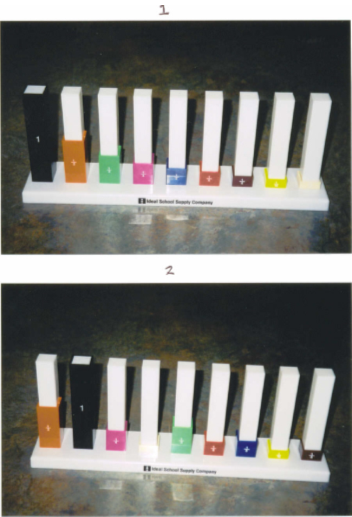
Now, it was Zachary's turn to play with this item. He immediately sensed anxiety and/or frustration from seeing things "not complete"... so, he turned the stacks around to make all the fraction pieces fall off - as I had expected! He then "started over" on his own... doing things the way he wanted them... in an ordered, "all or nothing" manner as shown in the first picture below. By this, I meant that ALL the pieces had to be on the stacks and in the right place. For Zachary, at first, there could be no pieces left on the floor and no mixing of colors... his "all or none" world mandated that! I worked with him a long time, calling out the "parts" and adding them to make the whole for each stack, as described in the example above.
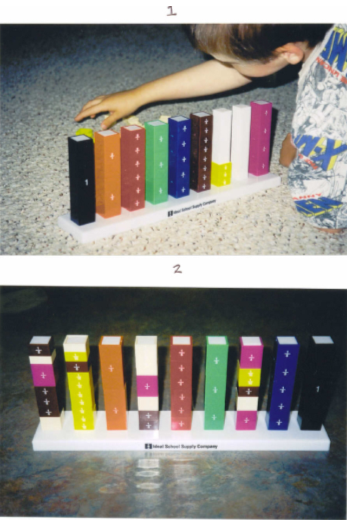
I then took the stacks and started to "mix them up", calling them "mixed up stacks" as I did this - to provide that all too necessary "label" - labeling everything, I found, was key to helping Zachary cope with the "unusual", the "unknown", and/or "the new". Notice I still used all the pieces. I then waited to see what Zachary would do with the mixed up stacks...
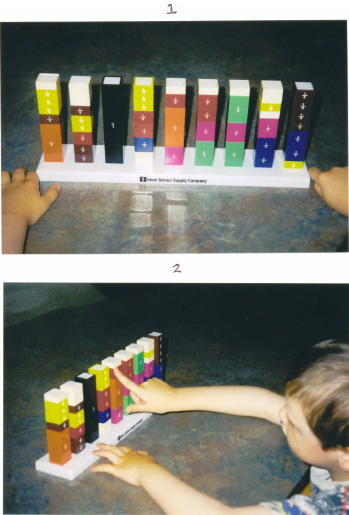
To my surprise... Zachary did not flip over the stacks to "undo" the mixing and matching of sizes and colors. Instead, he ran his fingers "up and down" each "mixed up stack"... he was "taking in" the variation. After doing this a little, he then flipped over the stacks to "undo" them. So, mixing of colors and sizes was no longer "as big an issue" as it had been slightly earlier. Zachary adapted rather well to that.
The variation that absolutely drove him crazy - as I knew it would - was the "incomplete" or "partial" stack! I stacked the pieces as shown below. I did not "complete" the task and put the missing pieces aside where he could not get to them. Right away, Zachary went ballistic, screaming and then taking the stacks and flipping them over and scattering the pieces everywhere so that they were no longer seen as part of a "whole" (exactly the same behavior I had seen in the past with the plactic egg exercises - See Plastic Eggs section)! I had fully expected this to happen... and sure enough, it did!
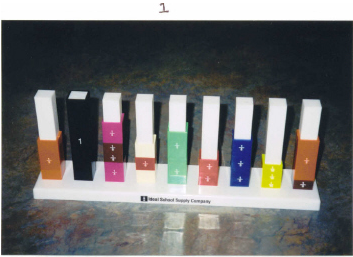
Zachary played with the Fraction Stax for over 4 hours that day... at times with me there, and at times, on his own... just to "experiment" by himself.
When "partiality" became too much of an issue, the result was always the same (see Exercises for more on this) - Zachary either looked for that all important "order fix" and if one could not be found, then the "partial" had to be completely, and again, as in this case, actually physically separated from the whole... so that the pieces were no longer perceived as something associated with the "whole". Those pieces he had so much difficulty making sense of were forced into randomness... an unexpected coping mechanism for the autistic child... yet, when looked at in terms of inability to deal with the partial in "anything", even this coping mechanism now made perfect sense!
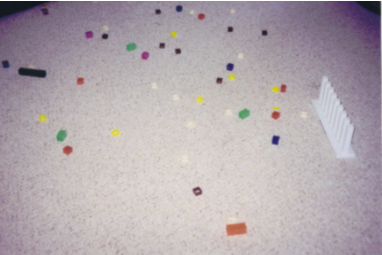
There was, however, one very interesting thing Zachary did start to do... he started stacking the pieces so that they went "beyond" the stack... something totally new! These were "labeled" as "smokestacks" (a “new”, whole entity – a “smokestack”) by Zachary. For example, he would take the 1/2 piece, top it with a 1/3 or 1/4 piece and then top that with another 1/2 piece so that the stack now went "higher" than the normal level... beyond the others... and he was totally fine with that - because this was now a new entity.
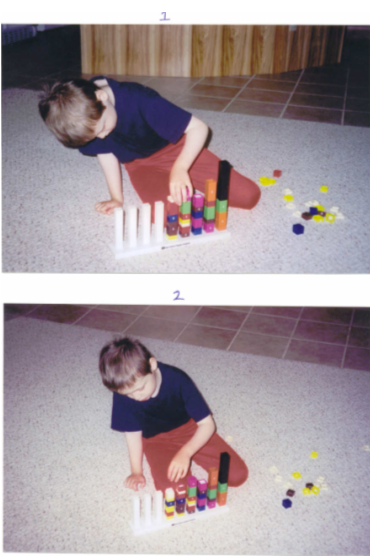
So, this was very interesting... the "beyond the whole" was ok... it was really just the "partial", the "less than whole" that seemed to be an issue and still was... and that was why understanding fractions was so key to children like Zachary. To recognize that parts made up the whole would be critical... and would be applicable to everyday life to help autistic children cope with the "partial" or "in between" situation. For example, opening the door 1/2 way... the fraction provided the "label" that was so critical to Zachary for him to accept this as "normal"... to be able to say: "Oh, this is 1/2 way"... to understand that concept! And actually, when I used the 1/2 open door example with Zachary, I could see him "clicking"... understanding what I was saying and "thinking this was cool"... providing that label... I was convinced this was key!
The importance of labels in the life of the autistic child simply could not be overestimated. It was the use of labels that allowed the child to perceive the "part of the whole". For example, in the pictures below, Zachary decided to make a "Fraction Stax Truck". He decided to create "a new, whole" with the "parts" before him... yet, another coping mechanism... only this one had a double-edged sword!
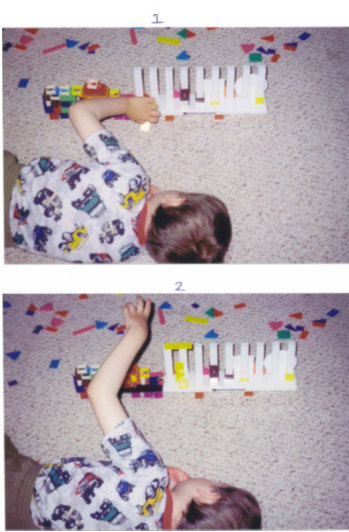
The creation of the "Fraction Stax Truck" allowed Zachary to cope with "the in between", the "partial", because, now the object before him was no longer a "Fraction Stax" with missing pieces that caused so much frustration, the object became a Fraction Stax TRUCK! It was no longer its previous "self" and had been replaced by a "new entity". This object, now, was labeled by Zachary as his Fraction Stax Truck and Trailer.
Since trucks and trailers varied in real life, he seemed perfectly fine with having "partial" pieces on the truck... it did not have to be perfect... just to look like a truck was sufficient. A trailer could have "pieces" on it, because trailers hauled stuff... and so, even fraction pieces were ok. Zachary now saw the "Fraction Stax" not as the tool it was intended to be but as a whole new entity... a truck. He was happy and content with that new entity. Frustration had left him since he was even able to "walk away" and "leave his truck" all by itself. Gone was the need to scatter all pieces - my valuable tool, once viewed as too frustrating, had been replaced by something Zachary could better cope with... a new, whole entity... in this case, a truck and trailer... and this now became his focus.
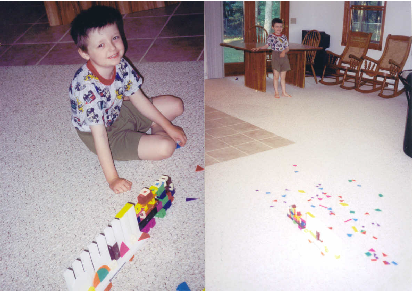
The point here was that this coping mechanism allowed Zachary to see this Fraction Stax as a new entity... a truck and trailer... and with that came the problem. His coping mechanism, literally, had done away with my teaching tool – a very detrimental result indeed! Zachary no longer wanted to use the object as a learning tool to teach fractions. He simply wanted to "make his truck" - no matter how hard I tried to simply use the tool to teach fractions again. So, the "creation of a whole and new entity from partial entities" became a coping mechanism with a double-edged sword. The trick, perhaps was to make absolutely sure Zachary had learned the concept of fractions before allowing him to use the tool as "something else". As a person “blazing the trail” on issues of partiality, however, for me, this had been a huge problem!
Over and over again, I had seen Zachary "take" to a specific task and then not want to do it any longer -ever! He "just did not seem interested in learning the concept any more" (although I think he did have a very good understanding of it simply because I worked with him for just over 2 hours to start with and I knew he understood what I was doing). He had turned my tool into something with which he could better cope and so, it became very difficult to teach using any repetition - something believed to be so necessary in many learning situations. Yet, his coping mechanisms prevented that repetition from occurring. This had been a very difficult issue to overcome with Zachary - and I suspected it would be, similarly, with all autistic children. This would certainly explain why behavior therapy could be so difficult with these children. The creation, or simple "perceiving" of a "new entity" made it very difficult to go back to the original task/lesson at hand.
Interestingly, the "Fraction Stax truck" then completely took over and it too became a source of frustration. The Fraction Stax, literally, had become a truck in Zachary’s eyes and now, that “new entity” presented frustration in and of itself, too! Now, this “new entity”, if not perfectly aligned or "just right", resulted in the eruption of tremendous frustration once again. Now, there could be no truck without a trailer... the wheels had be able to sustain the whole, with no pieces falling off as that would send Zachary screaming.
I had spent $25.00 on a tool that had been turned into something I now had to find new ways of using. This demanded a great deal of creativity. I suppose I could have called the stacks "brick stacks" to create yet another entity in Zachary's mind. Unless I was able to "constantly create new entities" with my tool, that precious Fraction Stax would become completely useless!
Of course, there were ways of getting around this. A simple option of "putting it away for a while" and then, later, taking it out again to try once more to use the tool for its intended purpose was something I had done with many other tools and that often seemed to work. In spite of these difficulties in overcoming Zachary's coping mechanism tactics, however, I had accomplished what I wanted. Zachary did after all understand the concept of fractions... and to me, that was key. I could then apply that concept to so much more in his life... to help him cope with his world and issue with partiality!
The need to constantly be looking for "something new" in teaching these children - to keep one step ahead of them - I had found to be true in so many things I did with Zachary. I wondered how I would teach concepts like math, language and so much more that seemed to necessitate repetition. Often, working with Zachary felt like an overwhelmingly difficult and exhausting task - in spite of the progress we were making. Patience, understanding and creativity - if you did not possess these qualities, working with an autistic child was certainly a way of working on that! :o)
Tool 2 - Fraction Pieces - by Didax
Another great tool for the autistic child...
Parents could buy a lot of different fraction products – you could probably make your own, too! I also liked this one in particular. I would have preferred having the pieces labeled as were the Fraction Stax, however, there was also something to be said for having the child learn to count the pieces for each "whole"... thereby helping him learn the fractions even more... so, I went with this particular product... and found it worked well too!
Pieces that "snapped together" and "stacked on top of each other" would have been great... but I found none like that! It was rather time consuming and distracting to try to always “put these together properly” and that was why, ideally, “snap on” type pieces would be much, much better. Anyway, the idea here was pretty much like that described above in Fraction Stax... startinf with the ordered and moving to the mixed up... then taking pieces, counting up to the whole ... each time. Having various fraction tools on hand, in my view, was also a good idea. When one tool assumed another identity, I could pull out another! When that one, too, took on a new identity, I could pull something else out (i.e., I could use a pair of scissors and paper and make my own fraction pieces and put them together or I could use a pencil and draw fractions, etc.).
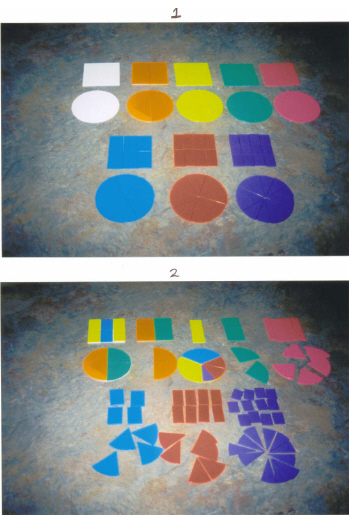
The first picture below was the one that turned Zachary "ballistic"- obviously - when my circles looked like "pacmans"... with a piece or two missing from the whole. I also "stacked" these circles on top of one another as I did them, adding the parts to make the whole each time...calling them out each time... same thing for the squares... then, I removed pieces and worked backwards to give Zachary enough exposure to the task at hand... this resulted in "some stress" - when I removed parts... but, if I called out "how many were left" (i.e., 12/12th minus 1/12th = 11/12th) as I removed the first piece from the completed stack, I found it provided a coping mechanism in that there was the "anticipation" of the next "complete circle" followed by the stress of the "partial" as the "next" circle or square was "slowly pulled apart" while calling out the "subtraction" of fractions. For example, 12 twelfths minus 1 twelfth = 11 twelfths and all the way down.
Note: It was important to do "proper labeling" to "maintain" the concept of "part versus whole". For example, I would NOT simply say 12-1 = 11... that would be wrong... these were FRACTIONS and they needed to REMAIN as FRACTIONS... that meant TWELFTHS (in this example) and so on. The ONLY whole number that should EVER be used in this entire exercise was the number ONE...when you reach "the whole"... pronunciation was also key... I was not working with "twelve" but rather "twelfths"!!! Since Zachary could read, I could show him the actual spelling of words dealing with fractions and that was helpful too (i.e., half, third, quarter, fifth, sixth, eighth, tenth, twelfth)!
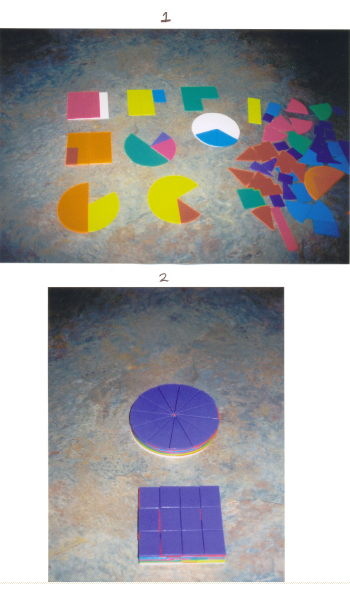
Words That Teach Quantity!!!
There were several words - words to teach quantity - that, if used in conjunction with the above "fraction" exercises, really helped Zachary gain a greater understanding of the entire concept of the "part" verses the "whole". There were certainly many more, but these words were a good start to help teach the concept of "quantity".
|
a couple |
each |
how much |
none |
some |
|
a few |
empty |
in between |
not quite |
somewhat |
|
a piece of |
enough |
just about |
one |
sparse |
|
all |
equal to |
less than |
only |
too little |
|
all but |
every |
a little |
part of |
too much |
|
all done |
exactly |
Many |
partial (ly) |
totally |
|
almost |
few |
Much |
plenty |
various |
|
any |
full |
Multiple |
scarce |
very little |
|
as good as |
group |
Nearly |
several |
very much |
|
as much as |
how many |
No |
sole |
whole |
There were undoubtedly more such words, but these gave me enough to work with!
I used these words in asking Zachary to give me a certain amount of the fraction pieces I had for the exercises above. When Zachary was able to give me the "correct amount", I knew the lesson of "fractions" had been learned and I could apply the concept of parts to the whole and generalize to the "real world". I could now say: "Give me "some sand in the bucket".... or "fill the bucket 2/3 of the way up", etc., etc., etc.
In no time at all, I was already seeing this work in some aspects of life for Zachary and I was confident teaching the concepts of "fractions and words of quantity" would work for many, many other autistic children as well! The only thing was to work at avoiding those "coping mechanisms", like the creation of randomness and the creation of a whole, new, entity. Perhaps the trick to that was simply to do much shorter "sessions" in teaching these concepts. Enthusiasm could sometimes have a way of working against you. :o)
The key was to constantly come up with "new labels" for the task... to show the child that you were using the same tools to do "something different". This was a very difficult task... but this was the key to having "continued use" of these excellent tools that could so help the autistic child deal with his world and his issues with partiality!
Using Body Parts
Perhaps the cheapest and easiest thing to use when it came to helping Zachary cope with issues of partiality were my physical body parts... my hands, my feet, my arms, my legs, and my eyes.
I found that for Zachary, anything out of the "ordinary" caused frustration. Knowing the "adversary" allowed me to use it to my advantage.
Consequently, I could use almost anything to help Zachary deal with his frustration... even my body parts.
For example, I used my body parts as teaching tools. I could lay down on the bed, with one knee up, the other leg flat on the bed. This created an "in between" situation... whereby the "legs" were no longer perceived as a whole but more as two separate parts. To Zachary, both legs belonged together - he could not tolerate the fact that "one was up" while the "other was down" and so he would come and literally push my knee down to make my second leg flat. As he did that, I raised the other knee. Or, I would sit down on the couch and put one leg up straight while the other foot remained on the floor. Zachary would come over and try to push down the leg that was raised, either by sitting on my leg or pushing it down with his arms. I could do much the same thing with my arms... using the ability to bend at the elbow for one arm while the other was straight out... or I could have one arm at my side, and one up. I could use my hands and put some fingers up... and some down...at the same time. Again, Zachary would try to put them "all up" or "all down". Or, I would open one eye, and close the other. Anything "out of the ordinary", any "partial" provided an opportunity for therapy.
As I did these things, I explained to Zachary the "odd position"... letting him know that "this was 'arm up' " or "left eye closed" showing him that “I was stretching” as I put one leg up was another good “explanation”. I always tried to make a game of things for him, joking as my body parts went up or down, closed or opened. These simple things allowed me to work on issues of partiality and to help Zachary increase his flexibility in terms of coping with real life. I found I could easily distract Zachary and make him see that sometimes, it could actually be fun to have one leg up and one down. For example, crossing my legs at the knee, although it caused Zachary frustration could also be fun as I could give him a "ride" on my legs and bounce him around. That was an easy way to help him see that things that were "out of the ordinary", such as crossed legs, could actually be fun too rather than simply being stressful! :o)
As with so much, many of the exercises I did with Zachary, things that were "everyday" activities for most children, were actually "therapy" for mine! :o) When I started these exercises with Zachary, there was always quite a bit of resistance, and indeed, a few screams too, but I had fully expected that to be the case. Knowing that helped me to cope as well as I could anticipate his response and “know how I would handle it” prior to it happening. It was important to never lose patience when I did these things… as difficult as they were for both Zachary and I to go through.
The Random Walk...
Going for walks provided many opportunities to "deal with issues of partiality". For example, instead of walking forward, I walked backwards, sideways, etc. - and I always made sure to label the specific "walk" for what it was. As I walked backwards, I said to Zachary: "walking backwards... mommy is walking backwards". At first, he tried to stop me... pushing me from behind in an attempt to make me go forward...so, I would entertain him and go forward a little... but, soon, I would "walk backwards" again. In no time, Zachary figured out that this "thing" mom was doing was "walking backwards" and having a label now made this an entity in and of itself... and as such, now, it was ok to "walk backwards".
Another thing I did was that instead of walking left, right, left, right, left, right (the way you normally walked), I went against the "normal" left, right, left, right, etc. , way to walk by moving my legs in a random fashion... what I came to call, "the random walk".
For example, I might do: right, right, left, right, right, right, left, left, left, right, left... As I did this, I called out each step (left or right) as I moved the appropriate leg (kind of like dancing down the street). I just made sure I was using a "random" pattern... something that had "no order" because that would have defeated the entire purpose of "the random walk". Every once in a while, I would throw in a "twirl", or "walking sideways", etc... labeling those motions too! It was just another way to "break order" and increase flexibility. Zachary was not able to "follow along" with his feet yet... but, this activity still frustrated him. Just seeing me do this was enough to increase his frustration level. As time went on, the randomness and silliness of the random walk became perfectly acceptable. If I spoke very slowly, and moved very slowly, Zachary would now try to do the random walk with me, but he still had trouble doing this activity (I suspect because of issues with motor coordination more than his lack of desire to do so).
"The random walk"... another simple way to help an autistic child deal with issues of partiality. For more on issues with direction, and how each direction, in my opinion was seen as a "part" to the concept of "direction", see my sections on "Odd Behaviors" and "Safety Issues" as they related to direction changes.
I could basically use the same concept while in a store shopping and "changing directions" or aisles... going down one aisle and then in the middle of it, "going backwards" as I said: "going backwards". This was fairly easy to do since Zachary was sitting in the cart, although, screaming somewhat. But, I could think of no store that did not have “some child screaming anyway”… so, I was not particularly worried about that. :o) I would just slightly begin to go down a new aisle and then, I would turn the cart completely around and go down another, saying: "no, not this one... let's go left, or let's go to aisle 3, not aisle 2". Labeling the aisles helped him cope... doing this in a grocery store or store that actually had numbered aisles helped tremendously because Zachary could focus on the "counting" aspect to each aisle as I did these things. The numbers to each aisle provided a coping mechanism to help him deal with "mom's indecision" as to where to go, what to do, while providing me with a great opportunity to further help him deal with issues of partiality! :o)
Using Household Items To Help With Issues Of Partiality...
Pretty well anything around the house, I could use in some way for therapy...as long as it provided an opportunity to "break order", "do the unusual", or "mix things up", thereby creating "parts" to a whole.
For example, I would put a bandages (a very colorful one that I knew Zachary would notice) on my face. I used to put bandages on my hands and fingers, but, I found Zachary could get to those too easily. To Zachary, a "bandage" was "not part of the skin"... it "did not belong there" and as such, that "part" had to be removed... so, he tried to rip these off my body (that was the reason I placed them on my face... they were harder for him to get to). When he was very young, Zachary had actually ripped a mole off my skin...now, I understood why... the mole, to him, did not "belong" there... it was a "part" that did not belong with the whole (the skin) and as such it had to be removed. In place of bandages, I could also use a piece of duct tape and place that on my face. Creativity, I found, was a definite plus. Of course, there always had to be an explanation as to the purpose behind the bandage – so an actual scratch or slight injury on the face was a plus! This was definitely something dads with shaving cuts could participate in! :o)
Or, I could simply put rubber bands in my hair...or barrettes...or clips... or clothes pins... anything that Zachary was not used to seeing on me was fair game. These were all "parts" that to him made no sense - until labeled! Once labeled, he could much more easily deal with these things.
I found even laundry to be useful in working with Zachary. His need for "order" made him think that "clothes were clothes and as such, they all belonged together"... the clean with the dirty. Now, I purposely left my pajamas on the bed in the morning...kind of hanging over the edge. I made sure there was a laundry basket somewhere nearby in the bedroom...and made sure there were a few pieces in there. Once he knew “hair clips” wee to “hold hair together”, he was fine with them being there!
Within seconds of noticing the "lack of order" or the "creation of a partial" by physically separating "clothes" and putting them in "different places", Zachary would try to put them "all together" again. . I then made sure I explained to him that the some clothes were "dirty" or "stinky"... and I showed him that those needed to go in the washing machine. Of course, Zachary then tried to put all clothing in the washing machine... so, I had to explain to him, over and over, that some clothes smelled good, and were clean and so they did not need to be washed. Just "telling" Zachary the difference between clean and dirty, however, I found not to be enough. I actually had to show him the difference. I actually made Zachary smell the "stinky" clothes and then smell the clean clothes , as I labeled each type, in order to help solidify the difference in his mind.
Even in this simple exercise, the inability to cope with partiality was so evident. Everything had to be "all or nothing"... for Zachary, integrating the parts into the whole was indeed a difficult task... one that had to be done consciously in each situation as opposed to the "automatic" integration of parts into a whole that was how his brain "should" have been working.
This was the same for pretty well anything... clean vs. dirty dishes, toys in the sandbox or the bathtub - they had to be in or out of the sandbox or bathtub...not some in and some out - piles of wood, sticks, rocks, acorns, etc. Zachary needed to learn that "mixing things" was ok ...like having both rocks and acorns in the same pocket...something he absolutely refused to do. He had to be taught that life need not consist only of the "all or nothing" - and in fact did not - only then could he truly come to cope with the world all about him.
Note: One of the beautiful things about doing this with Zachary was that I no longer needed to have the "perfect home"... for Zachary, some lack of order was actually a good thing and something he needed to adjust to/cope with because that was part of the "real world"! Although I was a rather neat person, I loved the fact that if I was ever behind on housework, I was now able to tell a visitor to my home that my house was in a slight mess "for a reason"... that it was “therapy”!! What a wonderful twist! :o)
Of course, there were limits to "disorder"... too much was NOT good. I found Zachary needed to be able to "perceive things as belonging together", or else the "disorder did not bother him". If things were just "one big mess", then he "could not spot those things that should belong together" and the "lack of order" in these "like things" was not bothersome to him. He had to be able to "perceive" that some things should probably "be together" (for more on this issue, see sections on Plastic Eggs and Wooden blocks to fully understand what I mean).
The Basket
Another exercise I did with Zachary was one whereby I gave him a small basket (anywhere from 4 inches to 8 inches across and perhaps 6 inches high) along with a whole bunch of everyday items in my house (small toys like blocks, plastic eggs, plastic toys, rattles, keys, beaded necklaces, rubber bands, very small stuffed animals, small plastic cups, etc.... really anything was ok here as long as it was not a safety hazard - scissors for example would be a definite "no"). I threw in a few medium size objects as well and gave him the basket and "other objects" I could not fit in because there were just "too many" objects to start with. I put all these on the floor next to him.
The idea was to give Zachary more than he could possibly put in his basket. I knew that Zachary would try to stuff absolutely everything into "his basket"... and he tried very hard to do so. The trick was just to make absolutely sure he had more than he could possibly fit into "his basket". Inevitably, no matter how hard he tried, however, some items fell out. At first, that caused him a great deal of frustration. Eventually though, he realized that it was futile to continue trying to "put everything in there" and he would eventually leave a few items behind... leaving a part to the whole behind. Once I saw him "ok" with leaving some things "out of the basket", I then did something else to work on the "all or none issue".
I would gently take something away from him...telling him, "I have to show this to daddy..." or something else like that to help him cope with the fact that I was "removing" something from "the basket"... taking away a "part to his whole". I would take the item and go show it to his father (who was in the same room), then I would bring it back to Zachary and let him put it back in his basket.
Zachary really screamed when "I stole something"... and he forcefully placed his hands over "his items" to prevent me from taking any of them. But, I would still manage to get one away and "go show daddy". Then, I would also take one of his items and place it on the refrigerator as he watched me do that. Again, this really sparked his frustration...but, I knew that each time I did something like this and I made his frustration "come out", that I was on the right track! In that situation, I would just tell him that “this was mommy’s and he could not have it” – again providing a reason or explanation as to why I was doing something – providing that all critical label and purpose!
Eventually, he learned to cope with what I was doing and his frustration decreases a lot. Again, it was all a matter of increasing his flexibility, decreasing his fanatic need for complete "all or none" order.... and of course, labeling everything I did for him - the label was always the golden key in helping him cope!
Using Puzzles In A Nonsense Way
It was a well known fact that autistic children were usually fantastic at putting together puzzles. Given that putting a puzzle together involved the creation of a whole, I now understood why this was a preferred activity among these children. Putting a puzzle together allowed autistic children to do away with the "parts" to form a whole... to integrate the parts into a whole!
I decided to use puzzles to do the "unusual", to "break order"... to use them in a nonsense way to help Zachary deal with issues of partiality. I found this exercise particularly troubling for Zachary. Of course, in making a puzzle, each piece had a specific place. I had one puzzle, in particular, that worked well for this exercise. It was a train puzzle (see below). It had two big wheels (blue and red circles), two small wheels (yellow and purple circles), two cars (yellow and red squares), etc. Each circle or square had a specific color and went in a corresponding colored place... at least that was how the puzzle had been "intended" to work. The particular puzzle I had was made by a company called Small World Toys. It was item number: 2547 and was called Loco Shapes. This company could be reached at 800-421-4153. I had purchased this puzzle through a local school supply store that provided multiple wooden puzzles. Any puzzle similar to this would work though.
The "colors" to the puzzle were supposed to be used to match the corresponding shape/color that fit into each part. That was the "normal" way in which this puzzle was supposed to be used. In dealing with issues of partiality and the "in between" situation, however, there were several things I could do with this simple puzzle to address Zachary's issues. :o)
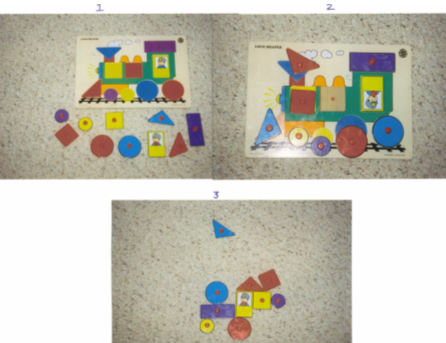
Obviously, putting all the pieces in the appropriately colored place was no problem for Zachary. But, what drove him absolutely insane was the fact that I put the small purple circle where the small yellow circle should go, or the red square where the yellow square should go, or the large blue wheel where the large red wheel should go, or the red triangle where the blue triangle should go. I also put some pieces "upside down (i.e., the conductor), or I flipped a piece around so that its color did not show but rather, Zachary saw its back wooden surface (see square in center of puzzle in picture 2 above). As I worked with this puzzle, I started by only making one thing "odd" or out of place and started from there.
This simple activity resulted in tremendously heightened stress levels for Zachary... much more so than any previous activity. I suspect the fact that colored pieces went in specific colored places had something to do with the intense stress level in Zachary. With the Fraction Stax, all stacks were white and so, they could more easily be moved around... but, with the train puzzle, each piece had a very specific place based on shape and color! This was by far the hardest exercise for Zachary to deal with! I had not done this one in a while since I had misplaced a couple of pieces but, once things settled down, I would be looking for those and pulling this one out again! I just hoped that Zachary did not decide to throw some of these pieces in the trash - perhaps a coping skill I had not have caught yet! :o)
To Zachary, the purple "wheel" went where the circle was colored purple on the wooden frame, the red square went where the square was colored red on the wooden frame... he absolutely could not tolerate the pieces being "mixed around" and not being "in their proper place".
In picture 3, Zachary "draws" something for me with his puzzle pieces – again, creating a new entity out of something frustrating... in this case, he was attempting to make a "tractor". You can see that the little yellow circle, big red circle, conductor piece and purple rectangle, when taken together, do form a tractor. Once again, he had created a "new entity" to better be able to cope with the situation before him. He would tell me what he was "drawing" with the pieces. Usually, it started out looking like what he said he was making, but then, his need to "use all the pieces", all the parts to the whole, inevitably made it so that the object no longer resembled what he was trying to make at all. But, to me, at the time, that was ok... he was still using the pieces in a manner that increased his flexibility... rearranging them in several ways on the floor...using them in a manner in which they were not originally intended to be used... and that in itself was good too! It was only much later that I came to realize the whole thing of “creating a new entity”. At the time we actually first started these exercises, I was just thrilled he was using things in a “new way”. But, later, I realized that “new way” could actually be a “detrimental way”. So, now, I still wanted to work on his overall "flexibility" in how he used objects... but, then, I always had that "new entity" in the back of my mind, too and the fact that creating "new objects" from frustrating situations was also clearly a coping mechanism... but, I decided I would take things one step at a time. I understood the issues I had to deal with, and that made things a lot easier for me going forward! When the new entity was created, perhaps I just had to treat it as I would any other imaginary play – defining it as “representing” something new, but “not really being” something new and making sure that the “old purpose” or way of using things was still understood! In the future, when I worked with this puzzle and any other such activities, I would always be careful that the “creation of something new” was understood for what it was and that “the original purpose of my tools” was explained concretely too!
I worked with him on trying to use just "some" of the pieces as opposed to his having to always use "all of them"... again, it was always the "all or none" principle with Zachary. I took a few pieces away (here the blue triangle) to help him slowly learn to cope with an "in between" or “partial” situation. Zachary still ended up putting it back. Actually hiding a piece or two also helped with issues of partiality.
Ultimately, I wanted Zachary himself to be able to put puzzle pieces where they did not belong and be ok with that - even if some pieces were upside down, flipped over, etc... and to be able to "draw" things without having to use every single piece. Leaving one piece out and providing a label of “unfinished” or “incomplete” also helped. This concept, I was sure would help with many areas as would my labeling our work as “working together”!
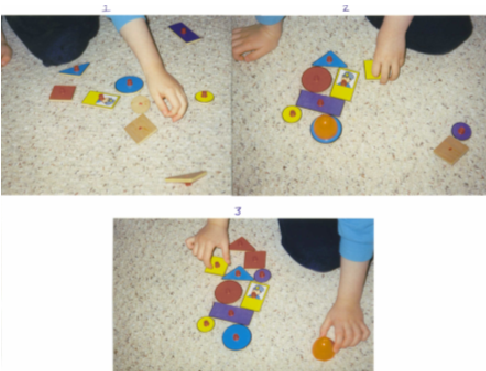
In the above, note how, again, I flipped some pieces over so that the "wood color" showed instead of the bright color on the face of the puzzle piece (see picture 1). Note that by picture 2, Zachary was already at work "flipping back" the pieces so that the bright side showed. Note also, that in picture 2, I added an orange "plastic egg shell half" on the large blue circle (barely visible, but definitely there). Finally, by picture 3, note that all pieces were "flipped back"... but also notice that Zachary has removed the orange egg shell part... since it "did not belong"... it was not part of the whole.
Note: Color pictures for all information in these materials could always be viewed on my website, for those readers who wanted to view the color images. It was just that to print this document in color, would literally have cost about two hundred dollars per copy because of the color involved (each color page costing about .79 cents to reproduce)! Those pictures that I absolutely had to provide in color, were found in the Appendix to these materials.
When I saw Zachary able to "leave the egg shell there" - I would know he was making progress. To me, it was all a matter of allowing for "in between", "out of the ordinary" situations. I could pretty well do this type of exercise with any puzzle. I did the same type of thing with a wooden puzzle I had for the alphabet.
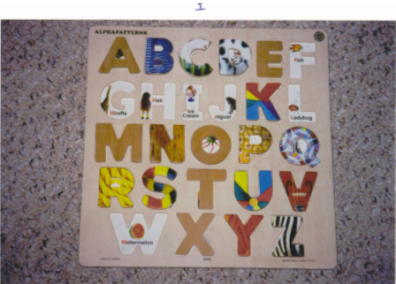
I left some pieces out on purpose and usually placed them somewhere on the carpet nearby so that Zachary could see them. He could not tolerate that - he wanted them "in place". It was always an "all or nothing". If I removed some of the alphabet after he had "put them where they belonged", he got very frustrated and threw the whole puzzle in the air...making all the pieces go flying. I also turned letters around, so that he saw the back or "wood" instead of the color on the face of the letter. I could do that for letters like "A", "E", "M", "O", "S", "T", "W", "X", "Y", Z". Again, that drove him totally insane. But, I kept "mixing things up", "breaking order" - trying to increase his flexibility. To a normal child, this would be something "funny to do", and certainly, not that stressful. That was definitely not the case for Zachary. These puzzle exercises definitely "hit a nerve"! He needed a lot of understanding, hugging and verbal reinforcement when I did these things. I always said, "let's make it different", or "that's so silly"...but, still, this was a very difficult one for him...labeling things as "upside down" made them easier to deal with... more proof that order, labeling and partiality were key!
In April of 2002, I thought I had found the trick to helping Zachary with this whole "puzzle thing".
I was so thrilled... but, that would soon be short lived as I realized that again, the issue still had not been resolved.
I had put away Zachary's train puzzle for about 2 months. In late April of 2002, I pulled it out again. The same thing happened... if the pieces were out of place... he got very upset (not as much as he used to...but, still too much). So, I did not do much with him on that first day working on this again.
That day, I just thought about the best way to go about breaking his “all or none” need for order when it came to these particular puzzle exercises! The next morning, I really thought I had figured it out!
Zachary had a good understanding of "broken" and "fix it" - so, I used those concepts. I took out the train, and said, let's make a "broken train". At first he resisted a little as I showed him a "broken train"... by putting the pieces in the wrong place. As I did this, I told him, "you can fix it later". Of course, the first time or two, he tried to put the pieces back where they belonged...as he did that, I said, "you fixed the broken train"...and he happily said " the green train is all fixed" (green was the primary color for this little engine puzzle).
I then asked him to "make me a broken train"... and he did! He was finally able to put pieces where they did not belong. If we used the words "broken train", he was fine with putting pieces in wrong places and then leaving them there and walking away.
I could now use the concept of "broken" to my advantage in helping to teach him flexibility. Phrases like "let's do it the "right" way" to have him place pieces in the appropriate color coded spot...then, "let's do it the "wrong" way to have pieces in places they did not belong (equivalent of the "broken train"). The next step would be to add "let's do it another way"... where some pieces were in the right place, and others were not. The introduction of "another way" would be key to so many things... once he understood that concept, I was sure flexibility would carry over into so many other things! I was very very excited about this.
Well, my joy was short lived on this one. As thrilled as I was to have Zachary make a "broken train" and see him finally be able to put the train puzzle pieces where they did not belong, I soon realized that again... this still was not an "in between" situation. It took me no time at all to realize that now, Zachary wanted to make the train either "all broken" - with no pieces in the right place - or "all fixed" - with all pieces going exactly where they belonged. I then tried to make it a "mixed up train" (some pieces in the right place, others out of place)... that did not go over so well. I had not done the "train puzzle" in a while as I had let him enjoy the summer while I worked on sharing these insights, but this would be one we tackle again soon. I knew we were almost there though! I think if I worked on labeling it as "a mixed up train" then Zachary should be much better able to cope with the "in between situation". :o)
Sometimes stepping away from exercises and coming back to them a few weeks later, I found, was the better way to go... allowing me to look at something in a slightly different way the next time. Putting things away for a while was less stressful and allowed me time to get that new insight and at times, those new insights could open up so many more possibilities and opportunities for advancement. Finding the right label to teach everything and to minimize stress... that was indeed the challenge!
Plastic Eggs
Note: Although Zachary never tried to place plastic eggs in his mouth, some children may do so, and, that could certainly cause a choking hazard. I was always with Zachary when we did these exercises with potential chocking hazards.
In working with Zachary, I discovered that plastic eggs were a fantastic tool. I used about two-dozen in all (more than I could fit in one egg carton).
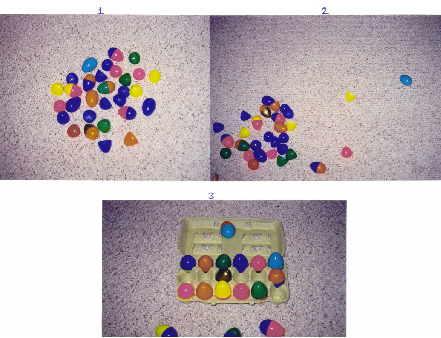
Although I did not show it here, the first thing I did with Zachary had to do with color only. I made some eggs a solid color, and others "mixed" ... but all eggs were "whole"... there were no "shell pieces". Zachary was not particularly troubled by "mixed color" challenges. That rather surprised me. Of course, I these eggs had been around our home for a few years and perhaps he had simply become familiar with the fact that they could be “whole” or “mixed” colors. I had done the "whole egg" exercise well before writing my first book, Saving Zachary: The Death And Rebirth Of A Family Coping With Autism, and actually figuring out what was wrong with Zachary. When I really started to figure out Zachary's problem, I discovered the "golden eggs" ... because these plastic eggs were fantastic for working with Zachary. I could do so much with them.
The first real exercise I did with Zachary was that shown in picture 1. In picture 1, I had put together both "whole eggs" with "egg shells" or halves. When I first sat down, all the eggs were in pieces or "shells", broken in two. There was not a single "whole egg" in the bunch. As I started to "put some eggs together", Zachary went absolutely insane.
He wanted all of them to be "shell pieces", not "whole eggs". As I put some together, he worked to pull them apart as fast as he could. When he saw he could not keep up to me, he literally got up and started stomping the eggs with his feet in an effort to pull them apart faster... and as he stomped, he screamed. I kept working with him on this and within just 10 minutes, already he could better tolerate the "whole" verses "partial" egg thing. Having egg parts and egg wholes together, had proved quite stressful for Zachary... and given his issues with partiality, I now understood this completely.
I then went to "phase 2" whereby I placed a few "whole eggs" and "egg shells" slightly away from the "pack". Again, Zachary could not tolerate that. To him, they belonged "all together". Unable to keep me from separating the eggs slightly, a coping mechanism set in... the creation of randomness. He kicked the eggs all over the living room so that they could no longer be perceived as somehow belonging together.
I found that with every exercise, Zachary had to perceive the "group"... meaning that things had to be close enough for him to perceive they "belonged together". When they were all scattered (usually by him), it was as though he did not "perceive" them as part of a group... they were just scattered objects all over the living room, and the distance between them made the fact that they were not "together" more tolerable. Thus, in attempts to cope, I found Zachary either physically separated himself from the objects of frustration, or separated the objects themselves!
Finally, picture 3 shows the addition of an egg carton. Here, I put some eggs in the carton, but others outside of it. Once again, Zachary could not tolerate the lack of "order"... the "partiality" in the situation... he always had to put them back "where they belonged"... all together. If I tried to prevent him from doing that, by removing eggs as he put some in, he literally took the carton and flung it in the air, again, scattering the plastic eggs all over the place.
Another thing I did was to provide more eggs than he could fit in the carton. There were a ton of things I found I could do with these simple objects. I also did "combos", as I called them.
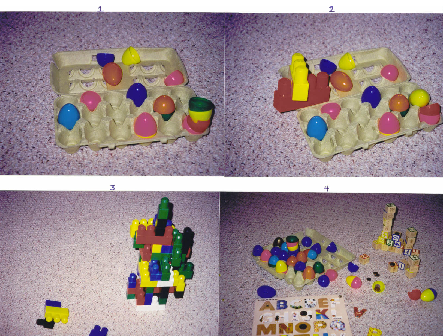
In picture 1 above, I put solid colored eggs and two colored eggs in the carton... along with both whole eggs and shells in the carton... in the lower right hand corner of the carton in picture 1, note how I stacked a bunch of shells one inside the other. Then, I added something that just did not belong, a couple of large Lego blocks. Of course, again, that drove Zachary absolutely insane and he quickly removed them – not understanding how these “parts” fit into the whole. “Parts” that could not be understood, were quickly discarded!
Picture 3 showed how I could do basically the same type of thing with large Lego blocks. Again, I just stack them in an odd manner and made sure there were a few left over pieces on the floor. I found, at first, Zachary had a very difficult time if the stack "tipped over", but, as I worked with him and kept telling him, "let's make it sturdy", or "it's ok... it's ok", he adjusted much better to the "tipping over". Picture 4 showed how I used a variety of objects at once... again, making sure normal order was broken... introducing many "parts" to the situation and scattering various pieces, slightly away from the rest of the group, etc. In picture 4, I used coins. I later decided to refrain from using any metal objects, including coins... they were just too dangerous...and it was not worth the risk! Many autistic children are known to have eaten metal objects, including metal safety pins, paper clips, thumb tacks, etc. I included this picture in order to make this point on safety, specifically because I knew that if I, as cautious as I now was with Zachary, had personally used coins or other small metal objects, chances were someone else may, too, and I did not want to see that happen!!!
There were plenty of everyday items that could safely be used in these exercises (i.e., puzzle pieces, egg shells, Lego pieces, pieces of paper, stickers, rubber bands, bandages, spoons, etc.) . The next set of pictures showed Zachary's reaction to the "lack of order"...
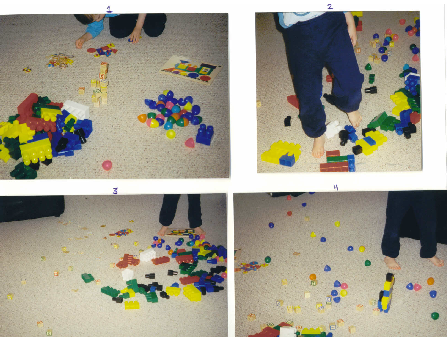
Note in picture 1, Zachary (very top and center of picture) was happily "drawing objects" with puzzle pieces - until he noticed the "lack of order" I had created all about him as he had worked quietly. Zachary got up and scattered the objects all about him... The wooden blocks were usually the first to go. I did not know if it was because they were more noticeable from a "3-D" perspective, but, in 99% of the time, they got kicked about first. After that, the plastic egg shells, Lego blocks and puzzle pieces were scattered about in no specific order. For Zachary, there was an intense need to "scatter" everything so that he no longer "perceived" the need to "group" similar objects. There were many times when he literally removed himself physically from the room so as not to see the similar objects I had "unarranged" or "unordered". Finally,
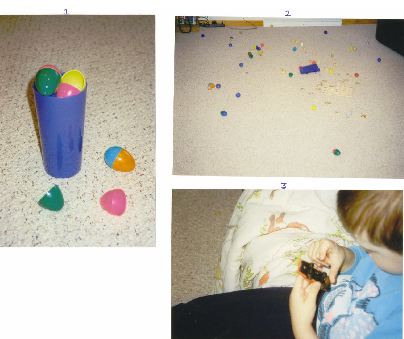
I also used a large cup in working with Zachary (a pot or other container of any kind also worked). The idea here was simply to give Zachary more plastic eggs than he could possibly fit into the container. Again, as he attempted to put all the eggs and egg shells into the cup, in vain, frustration set in and ultimately, the cup and its contents went flying throughout the room, as clearly shown in picture 2. Note that in wanting to deal with the stress, Zachary immediately went for an "order fix"... that was when his coping mechanisms came through... the "spinning" of the wheels on his little orange car, as shown in picture 3, the creation of randomness, the physical removal of himself or of objects, the echolia, the ordering language, etc. Over and over, I had found that if Zachary became too frustrated, he needed his "order fix", either physically, or through the use of his ordering language.
With Zachary, I could explain all his ordering language based on his need for order and the fact that ordering language was a coping mechanism he used to deal with frustration. If he was stressed out, Zachary started uttering things that made sense, or "had order".... things like, "circle, square, triangle....", "fan, fan, fan" (if you think about it, a fan and "spinning" provide "order"... a fan turns in a predictable way... and spinning went in a predictable way too, eliminating the "parts" or blades because as the fan spun, the blades became part of the whole!).
For Zachary, everything I saw in him in terms of behavior was rooted in his inability to properly integrate his world... in his inability to understand the whole without first understanding the parts that made up that whole – and anything he could not understand, in relation to the parts and the whole – he eliminated either physically or through the creation of a new entity!
Wooden Blocks
Wooden blocks, much like plastic eggs, were another great tool I used in working with Zachary.
It seemed to be human nature that when we were given a bunch of wooden blocks, we normally wanted to make a pyramid out of them or some kind of precise "stack". I found this to be true for Zachary also. But, again, for Zachary, my goal was to increase his flexibility, to allow for the unusual or the "non-perfect order" and to break the "all or none" need. So, I went “against” that innate desire to create the “perfect stack” to see how Zachary would react.
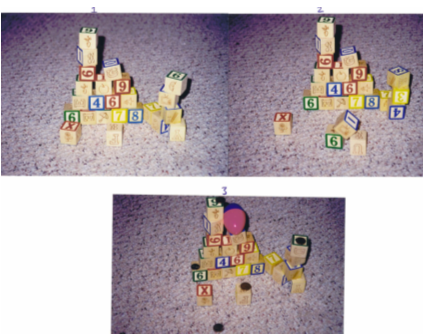
Note that I did not stack the blocks in perfect order. I always create "odd piles"... and I always made sure I left a few blocks off to the side, either in a smaller pile, or as a totally separate, single block on the floor, close to the "main pile". Note also that the blocks were arranged in random order, some upside down, some right side up, etc., and that the "vertical stacks" or the highest part of the stack was "staggered" – allowing for the introduction of an almost invisible “part” to the whole… “cracks” and “ridges” within the structure (see pictures 1 and 2 above). I had lone blocks, angled blocks, upside down blocks. I then added in "other objects" that did not belong, like a plastic egg or coins (again, as mentioned under the section on plastic eggs, I no longer used coins due to their potential hazard - there were plenty of other items around the house that could be more safely used).
For Zachary, it was always important to make sure he "perceived" the objects belonged together... if they were scattered all about, he did not "perceive" the need for grouping them as strongly. But, blocks arranged as above, with a few "stragglers" definitely made frustration surface! Having worked with Zachary on the "wooden blocks" exercises for about a month, I was already beginning to see small coping mechanisms set in. For example, Zachary now referred to piles as shown above as "smokestacks" (I did not know where he learned that word, but he was using it) to cope with the "lack of order"... he was associating what he saw with something similar in "real life"... and that was good, but there was also the issue of creating a "new entity" of my tools, too (see coping mechanisms).
Note that, if left to do as he pleased, Zachary preferred to make something that had a semblance of order... as in picture 1... it was not perfect, but very close – and all the blocks were used to make his “wall”. There were never pieces "outside of the whole"... he never left one piece "by itself" on the floor... everything was part of the whole... as was always the way things were with Zachary. Also, note especially in picture 2... how Zachary enjoyed "going over" the perfect pile he had made... not one block was disturbed as he did this. Fascination with order... and the whole... again! Note also that the actual "order" of the blocks in terms of whether or not they were upside down did not seem to matter. It was the fact that they were "part of a whole" that mattered!
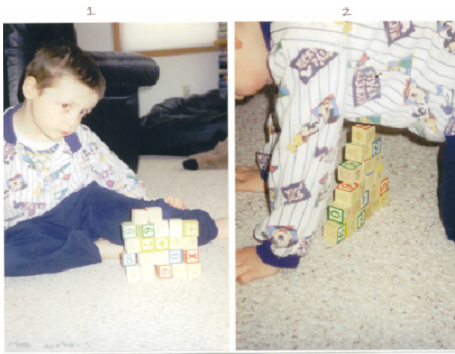
Play Dough
Play dough, or modeling clay was another excellent tool. If given the chance, Zachary would simply stack it all up in one huge pile...because to him, based on the need for order, "it all belonged together". I let him do that a little and then worked him away from the need to "clump" it all by showing him how to make things he liked... a snowman, a tree, a dog, etc. Providing labels for objects that we made had made it ok to make these objects. There was still that need to then "pile the rest on", however.
I tried to make things fun and different for him, and to show him how to cope with the unexpected, the unusual - the parts that did not seem to belong (at least until they were explained in terms of how they belonged in the whole), etc.
For example, when I made a tree, I had a bunch of branches sticking out of it. Then, I tried to "add apples" to the tree. I told Zachary this was an "apple tree". At first, since to him, the "dots" or "apples" just looked like little round balls on "his branches", he did not want them there. But, I kept adding them on, each time telling him my tree had "another apple", and eventually, he was ok with the fact that I had added these to the tree.
I then put a few apples in a separate spot, on the table, away from the tree and told him these "apples had fallen off". Of course, he resisted that, since apples "all belonged on the tree". So, that was another thing to work on a little more. Then, I added bananas to the apple tree....or I told him we had a broken branch, and I pulled one off the trunk and place it away from the tree. I added a "sun" and placed it a little further away. Obviously, there were countless things like this that I could do with play dough. The possibilities were endless.
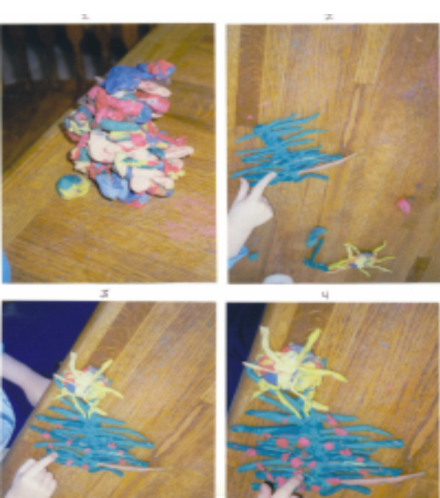
Simple play dough... another fantastic tool... something that could be fun and helped maintain interest as I continued to work on Zachary's need to learn how to integrate the parts into the whole. In picture 1 we were just starting to play with many, many colors. To Zachary, if left alone to do as he pleased, he figured all this stuff "belonged together" in one big pile... thus, bringing order to the "stuff". If pieces fell off the pile, he got very, very frustrated. I then took some away and asked him to make me a tree with the green. He started doing that. I then added "red dots" to his tree... he tried to remove them... to him, they did not belong there... until I labeled the tree as an "apple tree"... then the red dots were ok. I also had him add a "broken branch" (at first it was just on the "ground" below the tree). Labeling it as a "rotten" branch worked better... that way, it could stay on the tree rather than having to have "fallen down". I also had him add "rotten apples"... in the form of "brown dots" on the tree (in pictures 3 and 4). Note: I later learned that play dough had gluten in it although Zachary himself never seemed to react to it. There were gluten free play dough recipes available on the Internet though.
So again, it was really all a matter of allowing for the "in between" situation and showing Zachary how all the parts fit together to form a whole. Labeling absolutely everything was key! Labeling allowed Zachary to make things "different" from what he had rigidly put in his mind and allowed me to help him expand his understanding by generalizing these simple concepts to many other situations!
Plastic Shapes
I also purchased plastic shapes from my local school supply store. They came in various shapes, sizes, and colors. I went through their catalog to see what was available and had to order these special since they were not in stock. One of the sets I had was made by Ideal (item no.:7948). Wooden shapes would work too but they were much more expensive. These plastic shapes had cost, I believed, approximately $15.00 US. I simply gave these to Zachary and let him make anything he wanted – and the results were basically the same. He always strived for that “order” and did not want to leave any parts out. Once in a while, I would then "add something" or "take something away" from his creation, much as I had done in other exercises. When I left the room to work on the computer once, I came back and Zachary had made himself a perfect little bulldozer with a "front claw" (using white pieces), a "window and door" as he explained to me. He had made this in approximately 5 minutes (it probably would have taken me much longer to do the same thing :o) ). But again, we did both the "ordinary" and the "not so ordinary" in working with these. One thing was for sure, Zachary would probably make a fantastic engineer!
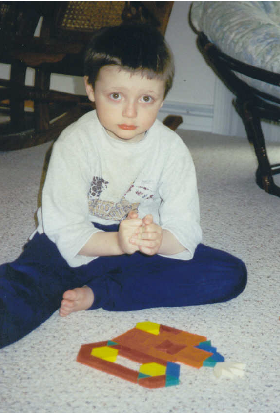
In working with plastic shapes, the first few times, Zachary literally tried to use all of the pieces – not wanting to leave any “stranded parts”. Soon, though, as with everything else, he figured out that he could “make new things – new entities” out of these shapes and as such, he slowly was able to move to using only “some pieces” but, that was because he had “created that new whole” in order to help him cope with issues of partiality and as such, that “new whole” always became his complete focus. If a part of the whole was disturbed, and say, a “crack” appeared, the entire thing would be quickly scattered all about!
Interestingly, I recently noticed that when I asked Zachary to pick up his plastic shapes, he picked some up and put them in the bucket, but not all of them… and he was able to walk away. So, that was very new and exciting for me. I truly believed that having provided for him that understanding of fractions now made it so that it was finally ok to leave that bucket only half full – and to walk away. This, I had only seen the one time, the day just prior to my completing this book. As such, although I believed it was due to the fact that the concept of fractions had played a part, it could have been that something else simply captivated his attention more… but, I did not think that was the case, since he was only very slowly walking about the room when he had stepped away.
Increasing Eye Contact In The Autistic Child
I encouraged parents to be aware of all the issues I had mentioned as they related to eye contact in terms of digestive enzymes, cod liver oil, color, light, motion, and of course, partiality and coping mechanisms involved in eye contact issues.
These exercises I did well before coming to the conclusion that breaking eye contact was a coping mechanism, but they did help Zachary to learn to focus on my eyes a little more. The best thing I did, however, in terms of the eyes and eye contact was in actually defining the “right eye” verses the “left eye” and by hiding each, showing Zachary that he needed “both” to see everything – that had provided for him the purpose, that critical label behind the need for “having two eyes”!
Eye Contact Exercises
Zachary knew his colors...so, one of the things I did was to ask him: "do you see purple in my eyes?", then, I would answer the question for him, "no, I do not see purple in your eyes"... I pretty well went through every color I could think of that was not in my eyes, and ended with the actual colors in my eyes, "brown, white, black, and yes - even red".
Zachary loved circles...that was his favorite shape and so I used that to my advantage too! I would say: "do you see the circle in my eyes?"... "do you see the brown circles?"... "do you see the black circles?", etc. Then I would say: "do you see my oval eyes?"... "do you see the red in my eyes?" Of course, at first, he did not really see the red, so then, I pulled down on the area just below my eyes to show him the red. I then ask him: "do you see the red squiggle lines in my eyes?" ... and showed him the red lines/blood vessels of my eyes. That made him aware of new "fascinating things" he had not noticed before. I also said: "do you see Zachary in mommy's eyes?"... to make him focus on the reflection in my eyes.
I asked him to "blow on my nose"...or "blow some wind between my eyes" with his mouth. I did anything at all to help focus his attention on that part of my face. I used similar questions to make him focus on my eyelashes, my eyebrows, my eyelid... of course, I always made sure I "labeled" everything for him...that was always critical! What I did not see until recently was that I had to also label the PURPOSE of each eye... this was what I addressed in the sections noted above on eye contact... and that label of the PURPOSE of each eye was critical to helping Zachary really move forward in terms of eye contact. His eye contact was much better since that simple definition of purpose had finally been provided (see sections on More Than Meets The Eye and Breaking Eye Contact As A Coping Mechanism)
Like so many autistic children, Zachary had preferred looking at the mouth area for some reason. I now understood why that was... the mouth provided a single entity in and of itself. The eyes did not provide a "whole" as did the mouth... the eyes provided "parts" to a whole (a face)... there were 2 of them for some reason... and Zachary could not integrate how they fit into the "whole picture" in terms of the face - until I explained that to him as described in my section on Eye Contact - More Than Meets The Eye.
I had tried the "look at me" exercises, but found Zachary did not respond well to that. I had always been of the opinion that things should not be "forced" onto Zachary... that there had to be a way of reaching him gently and in a fun way. I always focused on making things as fun as possible for him... on building the relationship. I knew that always saying "look at me" was supposed to help, but, in my heart, I truly felt there had to be a better way... I just had to find it!
I also worked on emotions as I worked on eye contact, saying: "do you see mommy's happy eyes?".... "oh, look, here are my sad eyes", "here are my surprised eyes", "here are my mad eyes", etc., and then, I tried to express “degrees” of each emotion, via my eyes and facial expressions.
This required constant creativity and work, but slowly, Zachary was making progress! Once the purpose of "eyes" had been provided, Zachary leaped forward in this area! :o)
Given the above examples in terms of exercises I did at home with my son, there were obviously countless ways to work on issues of partiality processing in the autistic child and his need to understand how to integrate the parts to his world in order to make a whole. Anything that allowed me to "mix things up" and to "make things different" - even if in just one way - was fair game. I could put things upside down for example and label that as "upside down" to help Zachary learn this concept... it was often as simple as that.
All this still required a great deal of work... but, once my energies were focused, Zachary made a lot more progress. In knowing and understanding the issues, I could then totally focus my energies in addressing those issues! In everything - labeling was key , as was explaining how things "fit together" and the purpose – the why things were the way they were (i.e., 2 eyes) or why they were done a certain way (i.e., item put on my refrigerator because it was “mommy’s” and he could not have it)!
In doing all of these things with Zachary, the challenge was always in keeping him the least frustrated as possible – althought that was very difficult at times.
In my view, as with everything I did with Zachary, I found the answers were in quickly identifying "what worked" and "what did not work"... in keeping what did, and in quickly throwing out the rest! In working on these issues, however, the “what worked” was always that exercised that caused him the most frustration. When I saw frustration, especially intense frustration, I knew I was on the right track!
Thus, in devising future therapies for these children that was always what had to be kept in mind. If you “hit a nerve”, it was for a reason – it was a “clue” as to the true underlying issue!
And, if a nerve was not “hit”, then I knew “that was not a problem area” and I moved on quickly. In these exercises I did with my son, it had been as I had done with all other tools… I identified what worked and kept that, and threw out the rest – quickly, because, in my view, if I was not “hitting that nerve”, I was “off base” and had to look elsewhere for the answers!
As overwhelming as these materials had surely been for parents, thus far, unfortunately, with the closing of this section, came the beginning of what I saw to be the most critical and yet, potentially emotionally devastating section for all parents of the autistic.
It was with a very, very heavy heart that I now shared with all parents my thoughts as to what I saw happening in the brain of the autistic child. :o(
The only comfort that I could provide for parents was that there was hope – but the road ahead was a very long one. Truly, understanding these issues was the first step in overcoming them… and, as overwhelming as this information would be – it was that hope that parents needed to hang on to, and the fact that many, many children had indeed overcome greatly these limitations – and, that this could be true for many others as well!
This was but a theory, and as such, parents needed to ask themselves if what I was putting forth made sense in terms of what we saw in the autistic. There was an inherent danger in “not wanting something to be true”, often resulting in denial of the facts, but, the facts were what I had attempted to put before you in these materials, and as such, I simply asked that all parents consider them objectively.
As with all my sections, I provided for parent thoughts on ways to perhaps overcome some of these issues! These key suggestions could make a world of difference in terms of helping parents in the recovery of their children!